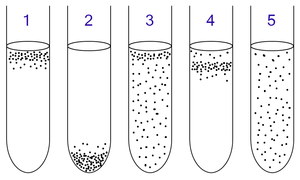| Revision as of 02:51, 27 February 2013 editClueBot NG (talk | contribs)Bots, Pending changes reviewers, Rollbackers6,439,386 editsm Reverting possible vandalism by 174.61.26.156 to version by Addbot. False positive? Report it. Thanks, ClueBot NG. (1529430) (Bot)← Previous edit | Revision as of 23:24, 11 April 2013 edit undoWavelength (talk | contribs)Extended confirmed users, Pending changes reviewers179,502 edits re-ordering sections—WP:ORDERNext edit → | ||
| Line 24: | Line 24: | ||
| ] is an example of a facultative anaerobe, which can develop in the presence of oxygen but does not require it. Individual ] are also facultative anaerobes: they switch to ] ] if oxygen is not available. However, for the whole organism this cannot be sustained for long, and humans are therefore obligate aerobes. | ] is an example of a facultative anaerobe, which can develop in the presence of oxygen but does not require it. Individual ] are also facultative anaerobes: they switch to ] ] if oxygen is not available. However, for the whole organism this cannot be sustained for long, and humans are therefore obligate aerobes. | ||
| ⚫ | ==References== | ||
| ⚫ | {{reflist}} | ||
| ==See also== | ==See also== | ||
| Line 34: | Line 31: | ||
| *] | *] | ||
| *] | *] | ||
| ⚫ | ==References== | ||
| ⚫ | {{reflist}} | ||
| {{Bacteria}} | {{Bacteria}} | ||
Revision as of 23:24, 11 April 2013

1: Obligate aerobic bacteria gather at the top of the test tube in order to absorb maximal amount of oxygen.
2: Obligate anaerobic bacteria gather at the bottom to avoid oxygen.
3: Facultative bacteria gather mostly at the top, since aerobic respiration is the most beneficial one; but as lack of oxygen does not hurt them, they can be found all along the test tube.
4: Microaerophiles gather at the upper part of the test tube but not at the top. They require oxygen but at a low concentration.
5: Aerotolerant bacteria are not affected at all by oxygen, and they are evenly spread along the test tube.
An aerobic organism or aerobe is an organism that can survive and grow in an oxygenated environment. Facultative anaerobes grow and survive in an oxygenated environment and so do aerotolerant anaerobes.
Types
- Obligate aerobes require oxygen for aerobic cellular respiration. In a process known as cellular respiration, these organisms use oxygen to oxidize substrates (for example sugars and fats) in order to obtain energy.
- Facultative anaerobes can use oxygen, but also have anaerobic methods of energy production.
- Microaerophiles are organisms that may use oxygen, but only at low concentrations.
- Aerotolerant organisms can survive in the presence of oxygen, but they are anaerobic because they do not use it as a terminal electron acceptor.
Glucose
A good example would be the oxidation of glucose (a monosaccharide) in aerobic respiration.
Oxygen is used during the oxidation of glucose and water is produced.
This equation is a summary of what actually happens in three series of biochemical reactions: glycolysis, the Krebs cycle, and oxidative phosphorylation.
Diversity
Yeast is an example of a facultative anaerobe, which can develop in the presence of oxygen but does not require it. Individual human cells are also facultative anaerobes: they switch to lactic acid fermentation if oxygen is not available. However, for the whole organism this cannot be sustained for long, and humans are therefore obligate aerobes.
See also
- Aerobic digestion
- Anaerobic digestion
- Facultative anaerobic organism
- Fermentation (biochemistry)
- Microaerophile
References
| Microbiology: Bacteria | |||||||
|---|---|---|---|---|---|---|---|
| Medical microbiology | |||||||
| Biochemistry and ecology |
| ||||||
| Shape | |||||||
| Structure |
| ||||||
| Taxonomy and evolution | |||||||
Categories: